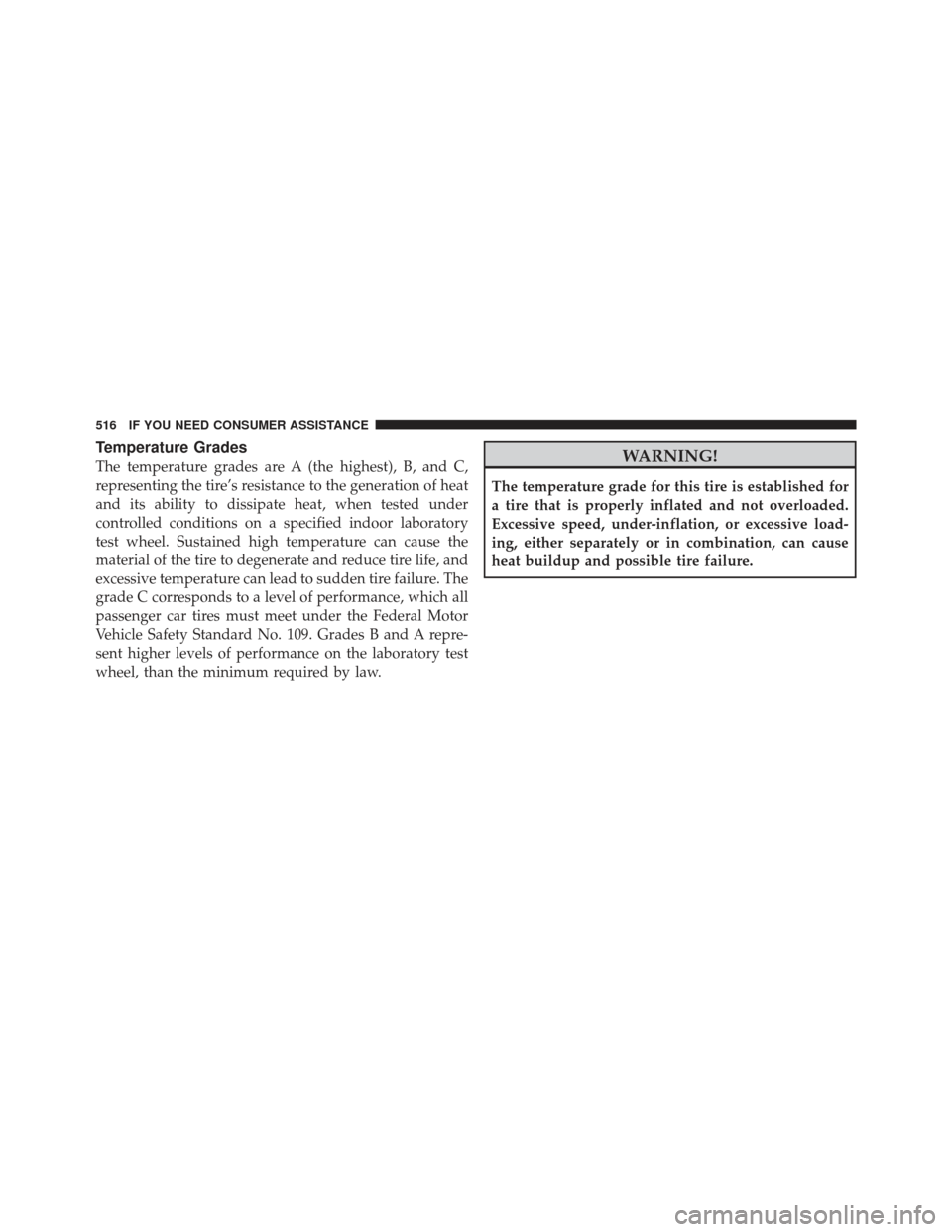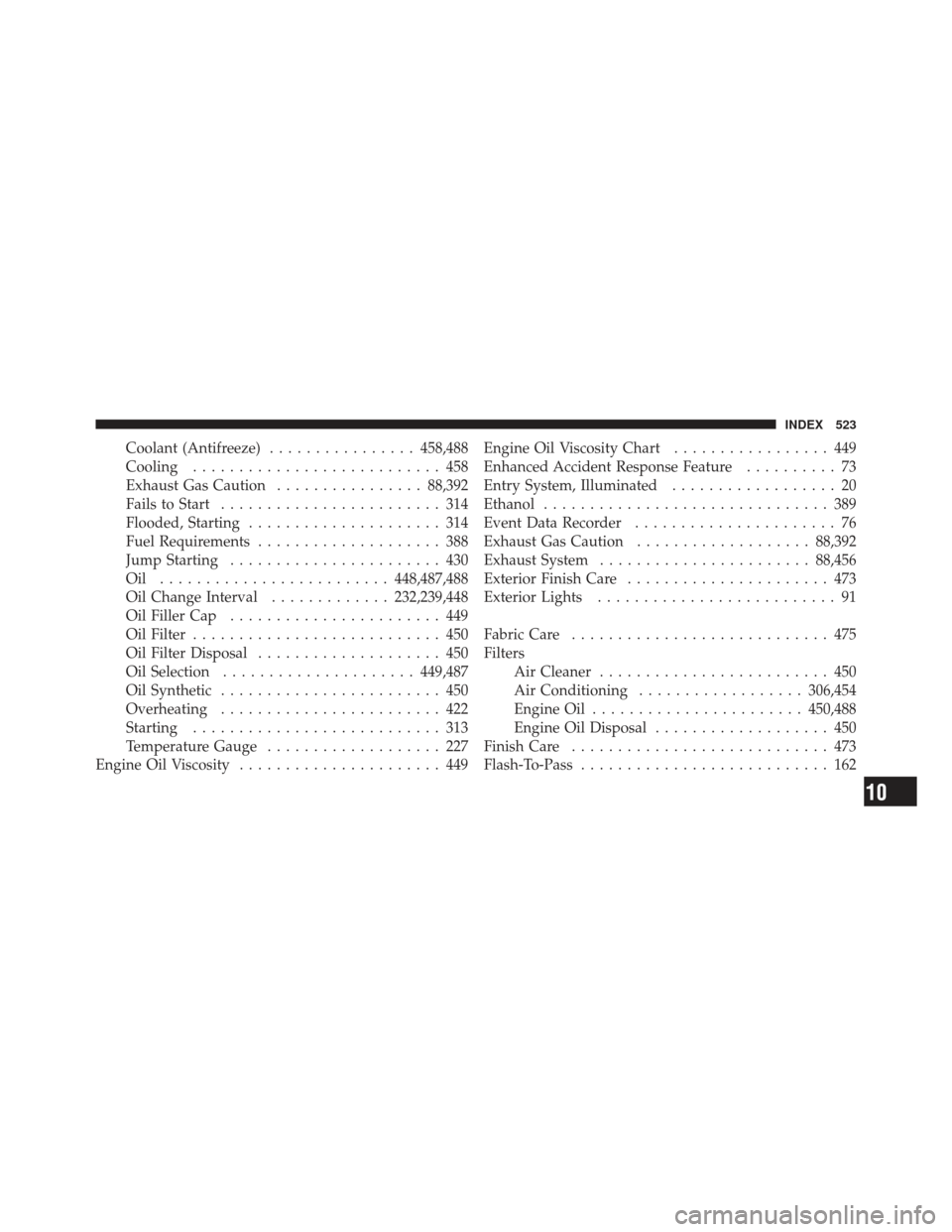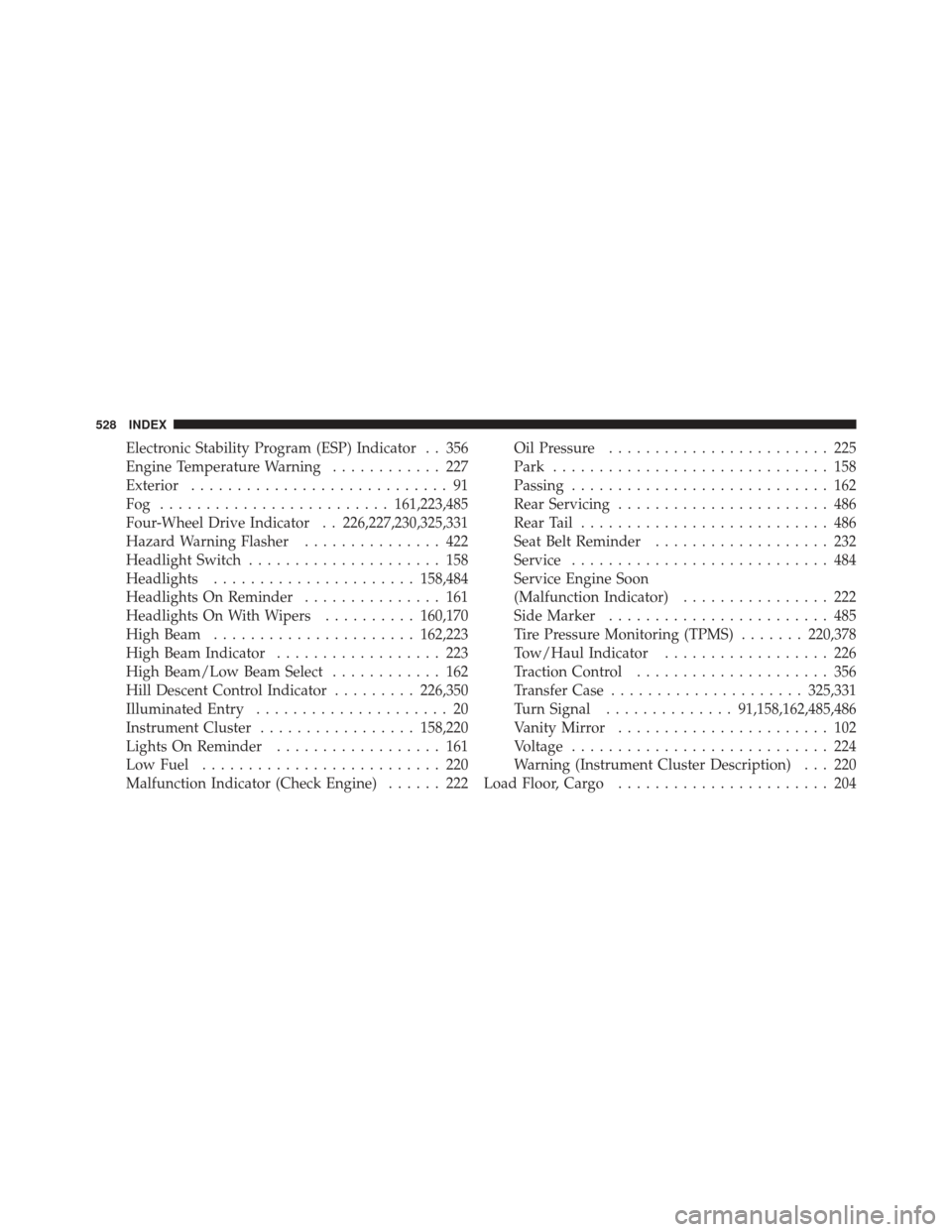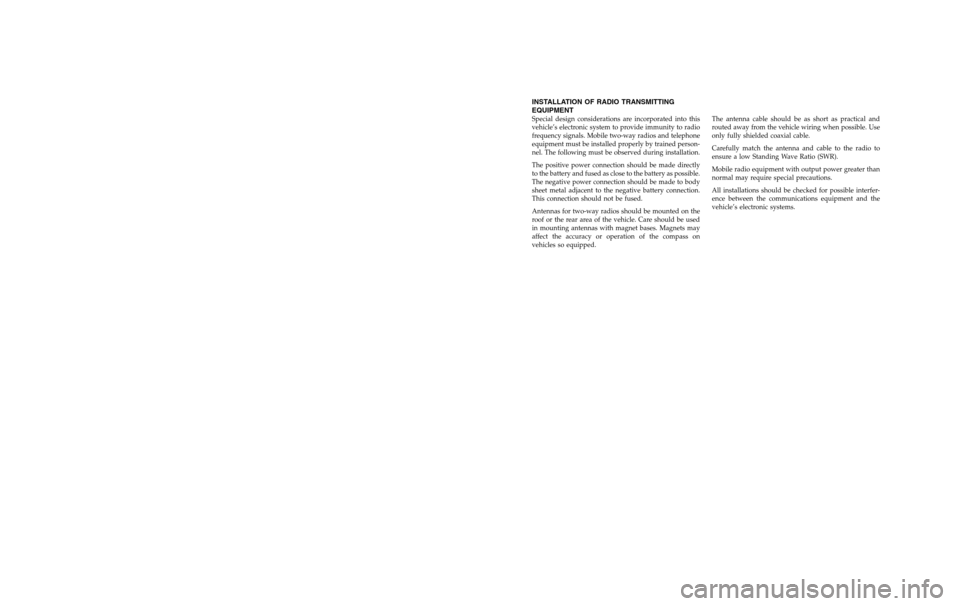2011 JEEP LIBERTY ESP
[x] Cancel search: ESPPage 518 of 542

Temperature Grades
The temperature grades are A (the highest), B, and C,
representing the tire’s resistance to the generation of heat
and its ability to dissipate heat, when tested under
controlled conditions on a specified indoor laboratory
test wheel. Sustained high temperature can cause the
material of the tire to degenerate and reduce tire life, and
excessive temperature can lead to sudden tire failure. The
grade C corresponds to a level of performance, which all
passenger car tires must meet under the Federal Motor
Vehicle Safety Standard No. 109. Grades B and A repre-
sent higher levels of performance on the laboratory test
wheel, than the minimum required by law.WARNING!
The temperature grade for this tire is established for
a tire that is properly inflated and not overloaded.
Excessive speed, under-inflation, or excessive load-
ing, either separately or in combination, can cause
heat buildup and possible tire failure.
516 IF YOU NEED CONSUMER ASSISTANCE
Page 525 of 542

Coolant (Antifreeze)................ 458,488
Cooling ........................... 458
Exhaust Gas Caution ................88,392
Fails to Start ........................ 314
Flooded, Starting ..................... 314
Fuel Requirements .................... 388
Jump Starting ....................... 430
Oil ......................... 448,487,488
Oil Change Interval .............232,239,448
Oil Filler Cap ....................... 449
Oil Filter ........................... 450
Oil Filter Disposal .................... 450
Oil Selection ..................... 449,487
Oil Synthetic ........................ 450
Overheating ........................ 422
Starting ........................... 313
Temperature Gauge ................... 227
Engine Oil Viscosity ...................... 449 Engine Oil Viscosity Chart
................. 449
Enhanced Accident Response Feature .......... 73
Entry System, Illuminated .................. 20
Ethanol ............................... 389
Event Data Recorder ...................... 76
Exhaust Gas Caution ................... 88,392
Exhaust System ....................... 88,456
Exterior Finish Care ...................... 473
Exterior Lights .......................... 91
Fabric Care ............................ 475
Filters Air Cleaner ......................... 450
Air Conditioning .................. 306,454
Engine Oil ....................... 450,488
Engine Oil Disposal ................... 450
Finish Care ............................ 473
Flash-To-Pass ........................... 162
10
INDEX 523
Page 530 of 542

Electronic Stability Program (ESP) Indicator . . 356
Engine Temperature Warning............ 227
Exterior ............................ 91
Fog ......................... 161,223,485
Four-Wheel Drive Indicator . . 226,227,230,325,331
Hazard Warning Flasher ............... 422
Headlight Switch ..................... 158
Headlights ...................... 158,484
Headlights On Reminder ............... 161
Headlights On With Wipers ..........160,170
High Beam ...................... 162,223
High Beam Indicator .................. 223
High Beam/Low Beam Select ............ 162
Hill Descent Control Indicator .........226,350
Illuminated Entry ..................... 20
Instrument Cluster ................. 158,220
Lights On Reminder .................. 161
Low Fuel .......................... 220
Malfunction Indicator (Check Engine) ...... 222Oil Pressure
........................ 225
Park .............................. 158
Passing ............................ 162
Rear Servicing ....................... 486
Rear Tail ........................... 486
Seat Belt Reminder ................... 232
Service ............................ 484
Service Engine Soon
(Malfunction Indicator) ................ 222
Side Marker ........................ 485
Tire Pressure Monitoring (TPMS) .......220,378
Tow/Haul Indicator .................. 226
Traction Control ..................... 356
Transfer Case ..................... 325,331
Turn Signal .............. 91,158,162,485,486
Vanity Mirror ....................... 102
Voltage ............................ 224
Warning (Instrument Cluster Description) . . . 220
Load Floor, Cargo ....................... 204
528 INDEX
Page 541 of 542

291680.ps 11JK72-126-AA Chrysler 1" gutter 05/14/2010 06:18:00
VEHICLES SOLD IN CANADA
With respect to any Vehicles Sold in Canada, the name
Chrysler Group LLC shall be deemed to be deleted and
the name Chrysler Canada Inc. used in substitution
therefore.
DRIVING AND ALCOHOL
Drunken driving is one of the most frequent causes of
accidents.
Your driving ability can be seriously impaired with blood
alcohol levels far below the legal minimum. If you are
drinking, don’t drive. Ride with a designated non-drinking
driver, call a cab, a friend, or use public transportation.
WARNING!
Driving after drinking can lead to an accident. Your
perceptions are less sharp, your reflexes are slower,
and your judgment is impaired when you have been
drinking. Never drink and then drive.
This manual illustrates and describes the operation of
features and equipment that are either standard or op-
tional on this vehicle. This manual may also include a
description of features and equipment that are no longer
available or were not ordered on this vehicle. Please
disregard any features and equipment described in this
manual that are not on this vehicle.
Chrysler Group LLC reserves the right to make changes
in design and specifications, and/or make additions to or
improvements to its products without imposing any
obligation upon itself to install them on products previ-
ously manufactured.
Copyright © 2010 Chrysler Group LLC
VEHICLES SOLD IN CANADA
With respect to any Vehicles Sold in Canada, the name
Chrysler Group LLC shall be deemed to be deleted and
the name Chrysler Canada Inc. used in substitution
therefore.
DRIVING AND ALCOHOL
Drunken driving is one of the most frequent causes of
accidents.
Your driving ability can be seriously impaired with blood
alcohol levels far below the legal minimum. If you are
drinking, don’t drive. Ride with a designated non-drinking
driver, call a cab, a friend, or use public transportation.
WARNING!
Driving after drinking can lead to an accident. Your
perceptions are less sharp, your reflexes are slower,
and your judgment is impaired when you have been
drinking. Never drink and then drive.
This manual illustrates and describes the operation of
features and equipment that are either standard or op-
tional on this vehicle. This manual may also include a
description of features and equipment that are no longer
available or were not ordered on this vehicle. Please
disregard any features and equipment described in this
manual that are not on this vehicle.
Chrysler Group LLC reserves the right to make changes
in design and specifications, and/or make additions to or
improvements to its products without imposing any
obligation upon itself to install them on products previ-
ously manufactured.
Copyright © 2010 Chrysler Group LLC
INSTALLATION OF RADIO TRANSMITTING
EQUIPMENT
Special design considerations are incorporated into this
vehicle’s electronic system to provide immunity to radio
frequency signals. Mobile two-way radios and telephone
equipment must be installed properly by trained person-
nel. The following must be observed during installation.
The positive power connection should be made directly
to the battery and fused as close to the battery as possible.
The negative power connection should be made to body
sheet metal adjacent to the negative battery connection.
This connection should not be fused.
Antennas for two-way radios should be mounted on the
roof or the rear area of the vehicle. Care should be used
in mounting antennas with magnet bases. Magnets may
affect the accuracy or operation of the compass on
vehicles so equipped.The antenna cable should be as short as practical and
routed away from the vehicle wiring when possible. Use
only fully shielded coaxial cable.
Carefully match the antenna and cable to the radio to
ensure a low Standing Wave Ratio (SWR).
Mobile radio equipment with output power greater than
normal may require special precautions.
All installations should be checked for possible interfer-
ence between the communications equipment and the
vehicle’s electronic systems.
INSTALLATION OF RADIO TRANSMITTING
EQUIPMENT
Special design considerations are incorporated into this
vehicle’s electronic system to provide immunity to radio
frequency signals. Mobile two-way radios and telephone
equipment must be installed properly by trained person-
nel. The following must be observed during installation.
The positive power connection should be made directly
to the battery and fused as close to the battery as possible.
The negative power connection should be made to body
sheet metal adjacent to the negative battery connection.
This connection should not be fused.
Antennas for two-way radios should be mounted on the
roof or the rear area of the vehicle. Care should be used
in mounting antennas with magnet bases. Magnets may
affect the accuracy or operation of the compass on
vehicles so equipped.The antenna cable should be as short as practical and
routed away from the vehicle wiring when possible. Use
only fully shielded coaxial cable.
Carefully match the antenna and cable to the radio to
ensure a low Standing Wave Ratio (SWR).
Mobile radio equipment with output power greater than
normal may require special precautions.
All installations should be checked for possible interfer-
ence between the communications equipment and the
vehicle’s electronic systems.